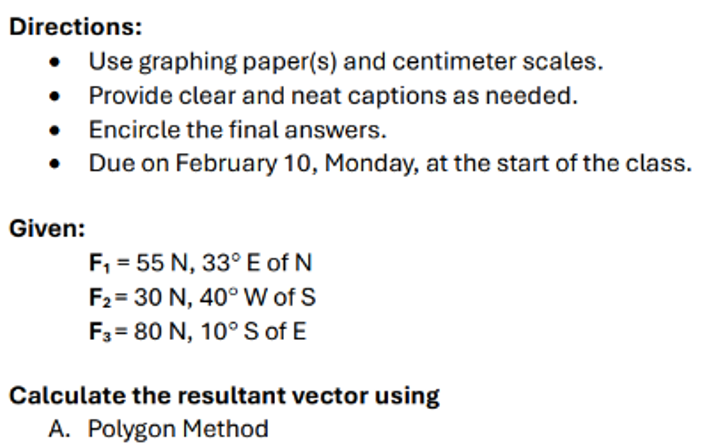Calculate the resultant vector of the following forces using the polygon method: F1 = 55 N, 33° E of N F2 = 30 N, 40° W of S F3 = 80 N, 10° S of E

Understand the Problem
The question asks to calculate the resultant vector of three given force vectors using the polygon method. This involves graphically adding the vectors tip-to-tail and determining the magnitude and direction of the resultant vector.
Answer
$\vec{R} \approx 94 \text{ N}, 28^\circ \text{ E of N}$
Answer for screen readers
Resultant Vector $\vec{R} \approx 94 \text{ N}, 28^\circ \text{ E of N}$
Steps to Solve
- Choose a suitable scale
Since we will be using the polygon method graphically, we need a scale to convert Newtons (N) to centimeters (cm) for drawing. A suitable scale is 1 cm = 10 N. This allows us to draw the vectors with manageable lengths on paper.
- Draw vector $\vec{F_1}$
Vector $\vec{F_1}$ has a magnitude of 55 N, which translates to 5.5 cm using our scale (55 N / 10 N/cm = 5.5 cm). It's oriented at 33° East of North. Draw this vector starting from the origin of your coordinate system.
- Draw vector $\vec{F_2}$
Vector $\vec{F_2}$ has a magnitude of 30 N, which translates to 3.0 cm (30 N / 10 N/cm = 3.0 cm). It's oriented at 40° West of South. Start drawing this vector from the tip of $\vec{F_1}$.
- Draw vector $\vec{F_3}$
Vector $\vec{F_3}$ has a magnitude of 80 N, which translates to 8.0 cm (80 N / 10 N/cm = 8.0 cm). It's oriented at 10° South of East. Start drawing this vector from the tip of $\vec{F_2}$.
- Draw the resultant vector $\vec{R}$
The resultant vector $\vec{R}$ is drawn from the origin (the starting point of $\vec{F_1}$) to the tip of $\vec{F_3}$ (the ending point of the last vector drawn).
- Measure the magnitude of $\vec{R}$
Using a ruler, measure the length of the resultant vector $\vec{R}$ in centimeters. Convert this length back to Newtons using the scale factor (1 cm = 10 N).
- Measure the direction of $\vec{R}$
Using a protractor, measure the angle of the resultant vector $\vec{R}$ with respect to a reference direction (e.g., the positive x-axis or North). Express the direction in a standard format (e.g., degrees East of North, degrees South of East, etc.).
- Approximate Result and Angle
Based on a graphical solution, the magnitude of the resultant vector is approximately 9.4 cm, which corresponds to $9.4 \text{ cm} * 10 \frac{\text{N}}{\text{cm}} = 94 \text{ N}$. The direction of $\vec{R}$ is approximately 28 degrees East of North.
Resultant Vector $\vec{R} \approx 94 \text{ N}, 28^\circ \text{ E of N}$
More Information
The polygon method offers a visual approach to vector addition, especially useful when dealing with multiple vectors. However, it is subject to inaccuracies due to manual measurement and drawing. Analytical methods (component method) provide more precise results.
Tips
- Incorrect scaling: Choosing an inappropriate scale can lead to vectors that are either too small to measure accurately or too large to fit on the paper.
- Incorrect angle measurements: Using the protractor incorrectly or misinterpreting the direction angles (e.g., confusing "East of North" with "North of East") can lead to significant errors.
- Not drawing vectors tip-to-tail: The polygon method relies on adding vectors sequentially, with the tail of each subsequent vector starting at the tip of the previous one. Not following this rule will result in an incorrect resultant vector.
AI-generated content may contain errors. Please verify critical information